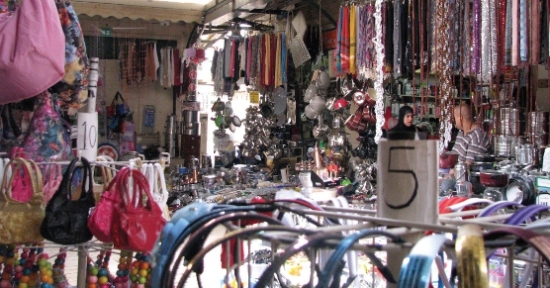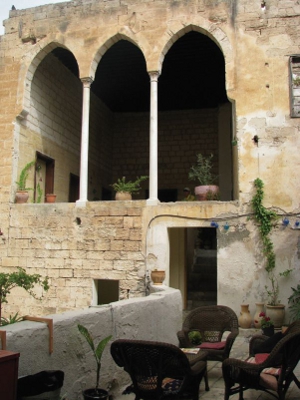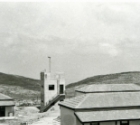
The old city has come alive as a tourist attraction
After years of backpacking in Australia, New Zealand, Nepal and the countries of South America, Maoz Inon, a former moshavnik, returned to Israel with the idea of opening a tourist hotel or hostel.
“Travelling from one place to another, I noticed that often the guest houses and hostels had become central places around which businesses, restaurants and other tourist-orientated enterprises developed. This is a concept that appeals to me,” he says.
After some time spent looking around he decided that Nazareth was a good place. It was central, near Haifa and Acre, and about a two-hour bus ride from Tel Aviv and Jerusalem. Most of all, he liked the many Ottoman-style stone buildings in the vicinity of the market. Many of these buildings, he noticed, had been abandoned.
The year was 2005 and the old city of Nazareth, mainly of the area around the open-air market, did not seem to promise much: businesses were closing and the streets looked neglected with broken street lights. Families had moved away and left behind deserted houses, some of which were occupied by squatters, and drug abuse was a growing problem.
"After the second intifada," comments Suraida Nasser, whose family has lived in Nazareth for generations, "the flow of tourists dwindled. Tourist companies were reluctant to include Nazareth as a destination on their itineraries and the old city seemed to be on the decline”.
But when Maoz looked at Nazareth he saw it's potential. “The place looked fine to me,” he remembers. “I had seen Lima, Cusco and much worse places in South America.”
Maoz visited the Business Development Center in Nazareth and inquired about renting an old house which he could turn into an inn or hostel. Mrs. Suraida Nasser, a Christian Arab working at the Center, overheard him. “We have an old house,” she said.
When Maoz saw the house he knew that it was exactly what he was looking for. A 200-year-old three-storey stone mansion, it had been built by Suraida’s great-grandfather in the Ottoman style with balconies framed by arches on slender pillars, marble floors and outdoor stone staircases which lead from an enclosed courtyard to the higher floors as well as to a basement (today the kitchen and dining room). The large rooms of the house have ceilings five meters high with, on one ceiling, beautiful decorative paintings of floral patterns and cherubs.
“It was love at first sight,” Maoz says. “This was the place I wanted for the new venture.”
The turnaround began slowly. At first Maoz opened three rooms, then later another three rooms, and so on. And as the tourists returned to the old city, so too did businesses in the vicinity slowly begin to reopen, reinforcing Maoz’s vision of a central place which encourages development.
Today, seven years later, part of the outdoor market is active and some shops have reopened, but many are still closed. The tourist walking along the old stone streets passes, one after another, great vault-like metal doors which are shut and bolted.
The narrow stone streets are well lit and clean, good for the walking tourist, but tough for cars. Cafes and restaurants are full. There are chairs and tables outside the restaurants in the large stone-paved square near Mary’s Well, and, after a hot day, we sat down with the many locals and visitors being served in the cool of the evening.
Much of the credit for the behind-the-scenes planning to bring the old city back to life belongs to the Nazareth Culture and Tourism Association. New hotels and hostels have sprung up to accommodate the increasing numbers of tourists. Unusual attractions such as the cultural Writers' House, museums and the Nazareth “village” (a living display of life as it was in Biblical times) have been upgraded. Taken together with the churches and mosques of the old city, and, amazingly enough, a Holocaust museum, there is a wealth of things to see and do.
Tariq Shihada, General Manager of the Culture and Tourism Association, notes that the Association has been working at plans to revive the old city for many years. At present old Nazareth offers around 1,600 rooms for tourists, and they are aiming for another 2,000 rooms over the next ten years. It seems very probable that some will be in the beautiful stone houses which were abandoned when their owners moved to new neighborhoods.
Mr. Shihada’s persistent lobbying of the Israeli government also paid off when, in March 2010, a $3-million plan for the development of tourism in Nazareth was approved.
Notwithstanding the statistics and upgrading, Tariq Shihada places an emphasis on the cultural aims of the Association, which plans festivals and enables artists to perform or display their works.
Some of the months of celebration are during Easter, Ramadan and Christmas. Events also include music, singing and folk dancing in September, and an oud festival in November. There are also year-round open air events including a festival held every Saturday evening near Mary’s Well.
The opening of the Fuaz Azar Inn has become a central point around which the surroundings have been upgraded. The municipality has done its part in turning the old city into a well-planned residential area and at night we saw a relaxed-looking police patrol come knocking at the inn door.
Volunteer workers from different parts of the world spend a minimum of six weeks working at the inn, and have helped in beautifying the surroundings by planting flowers and painting doors and walls, with unknown artists adding their talents in really artistic paintings, notably on the walls of the dining room.
Almost against her original feelings about the new venture, Suraida Nasser has today become an active partner at the inn.
She admits that at first she visited only occasionally, making sure that the picture of her great- grandfather, after whom the inn is named, was displayed in the reception room, and checking that everything met with her approval. Then she began to visit more regularly. She gives talks in the mornings to guests who are interested in the history of the building. She is very honest and forthright in her description of old Nazareth in the years before the inn was opened, and her feelings about starting the project with Maoz.
“Then,” and she laughs, “I began to come here every day.” She converted one of the many rooms into an art gallery where she sells olive oil soap from the West Bank and arts, crafts and handiwork done by Palestinian women from the refugee camp. “This enables them to earn a living,” she says.
On a personal note, this was the first time we had stayed overnight in the old city. Besides our good impressions of the surroundings, we were surprised by the many people who came to our aid, both in Nazareth and in the smaller towns along the Jesus trail – sometimes without our asking – when they saw we needed help. This happened several times when we got lost (our fault – we began in the wrong place) when walking on the first leg of the trail from Nazareth via ancient Tsipori to Kfar Cana (about 16 kilometers if you don’t get lost!).
The walking trail, an idea which began with Maoz and his American partner, David Landis, and which has the cooperation of the Society for the Protection of Nature and the Tourism Ministry, is a 65-kilometer four-day affair, stretching from Nazareth to the Sea of Galilee.

 ESRA Golf Competition 2012
ESRA Golf Competition 2012 Upside-Down Coffee – for another world. A Review
Upside-Down Coffee – for another world. A Review If I could tell you - a review
If I could tell you - a review-1450935317.jpg) Spending a Week in Tel Aviv
Spending a Week in Tel Aviv  Ma'ale Hachamisha
Ma'ale Hachamisha-1450857993.jpg) Jazz in a Pearl Garden
Jazz in a Pearl Garden  Mike Porter
Mike Porter